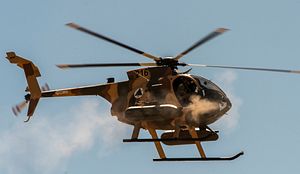The Afghan Air Force (AAF) is slated to receive 150 new MD530 F Cayuse Warrior light attack helicopters by 2022 bringing the total number of MD530 Fs operated by the Afghan Defense and National Security Forces (ANSDF) to almost 180.
The U.S. Department of Defense (DoD) announced on September 5 that it has issued a $1.38 billion contract to MD Helicopters “for procurement of an estimated quantity of 150 MD 530F aircraft and required production support services to include program management, delivery support, pilot training and maintenance.” The estimated completion date of the contract is 2022.
According to a MD Helicopters press release, the first deliveries under the contract will be 30 MD 530Fs for an estimated $177 million. The first part of the order is expected to be completed by September 2019. The AAF received the last batch of four MD-530F helicopters in August 2017. There are currently 27 MD-530Fs operated by the AAF in Afghanistan. As I reported previously (See: “Afghanistan’s Newest Attack Helicopter a ‘Total Mess’?”), a number of AAF pilots have criticized the size and capabilities of the helicopters in the past.
“Mission Equipment for these aircraft will include a ballistic crash worthy fuel system, consisting of a main fuel tank and a 38-gallon Auxiliary Fuel Tank, high capacity landing gear, FN Herstal Weapons Management System, DillonAero Mission Configurable Armament System (MCAS) weapons plank and Fixed-Forward Sighting System, Rohde & Schwarz M3AR Tactical Mission Radio, and FN Herstal .50 caliber HMP 400 Machine Gun Pods and M260 7-shot rocket pods,” MD Helicopters notes in the September 6 press statement.
The new sighting system is closing a critical capability gap of the MD-530F gunships in service with the AAF, since the first MD-530Fs lacked proper gun sights making them less efficient in close-air-support missions. The helicopters, however, still use only unguided munitions (2.75-inch rockets), which has led to a step increase in civilian casualties over the last year. As I noted in 2016, it is important to remember that air power alone will not be enough to help turn the tide in the ongoing war (See: “Afghanistan: Will the Afghan Air Force Make A Difference in the 2016 Fighting Season?”):
What will determine the impact of (…) new aircraft more than anything else, however, is how the A-29 [530MDFs] will be used during [this year’s] fighting season by senior Afghan military leadership, since this will have an direct impact on the military culture of the ANA for the years to come. (…)
Overall, the induction of the A-29 light attack aircraft [and MD 530F] will bring the ANDSF a step closer to becoming a more professional fighting force. However, we should not expect that the new planes will be able to reverse overall battlefield failures and the aircraft will certainly not be capable of guaranteeing battlefield successes on its own.
In 2016, AAF pilots conducted 800 airstrikes on 1,992 combat missions. A Pentagon plan calls for an increase of the AAF from currently 124 aircraft up to 259, and from 8,000 personnel to 12,000. The AAF is expected to receive $7 billion in support over the next four years, according to a senior U.S. military officer. The AAF continues to suffer from maintenance issues and it is unclear whether the AAF will have enough trained pilots by 2022 to man the new helicopters.

































